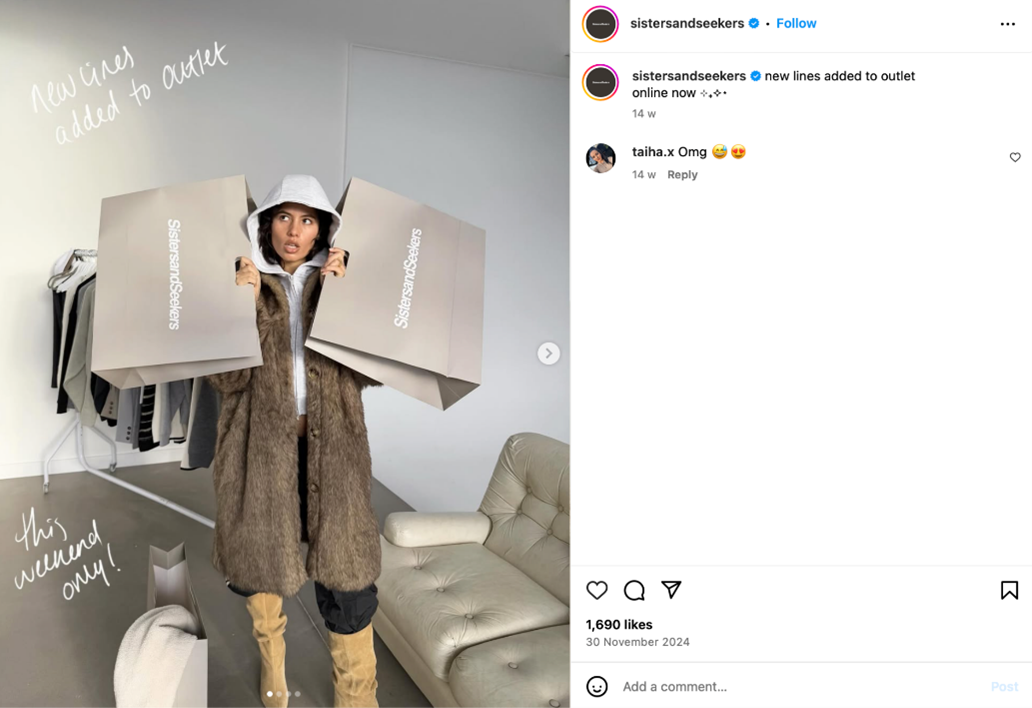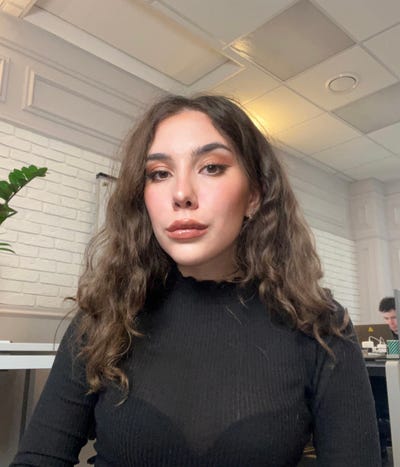Audiences tune out generic visuals and empty aesthetics. They prefer fresh content that makes them feel.
AI can generate art, but can it create visuals that forge an emotional connection? Nostalgia doesn’t focus on the present, so can it have an impact? Proof cultivates credibility, but how can you convey that in a novel way? And how do you reshape digital experiences that make static visuals a thing of the past?
Let’s explore five visual storytelling trends shaping content marketing in 2025, identified in interviews with the 99designs by Vista community and other marketing experts. (VistaPrint, the company I work for, conducted the interviews.)
1. Authenticity matters in visual content
Over half (59%) of consumers say user-generated content is the most trustworthy type of content, according to a 2021 survey by Stackla.
Where high-production visuals once signaled professionalism, consumers now seek unedited footage and in-the-moment visual elements that reflect reality — not curated feeds and a carefully controlled brand image.
This shift fuels two marketing trends:
Employee-generated content: Brands give creative reins to employees, capturing spontaneous, behind-the-scenes, natural, and relatable moments.
Community-centric marketing: Brands prioritize real people and everyday experiences to build communities and encourage user-generated content.
These design and marketing trends also reflect the rising demand for authenticity in visual storytelling:
Etches and imprints: Smudges, rough textures, and hand-drawn elements reinforce authentic imperfection in branding.
Pen-to-paper and fuzzy distortion fonts: Handwritten-looking and slightly distorted typography adds an authentic, human touch.
Unpolished, raw video: Lo-fi, unscripted footage wins over glossy ad campaigns.
Examples
Bibliotheque Nationale, a small Ukrainian fashion brand, ditched a polished campaign in favor of raw, real-time visual storytelling. Instead of a high-production launch, it hosted an Instagram Live from the dressing room in its boutique at lunchtime. The unfiltered look embraces imperfections, such as background noise and unpolished lighting. Instead of editing the footage, they kept every candid moment and the camera rolling as the viewer waits for the model to reappear with a new look.

Another great example of authentic content marketing is Sisters and Seekers. Its visual storytelling revolves around real customer interactions — screenshotting DMs, resharing Instagram Story tags, and letting organic moments shape their feed.

The intentionally casual execution uses chat bubbles, unedited phone screenshots, and a clean white background to keep the focus on the conversation. It adds a personal touch by handwriting directly onto photos, which reinforces the laid-back, unfiltered aesthetic. This stripped-down approach makes its content more intimate, relatable, and community-driven, proving authenticity doesn’t need embellishment to be effective.

How to implement this visual content marketing trend
Feature your community — customers, employees, and brand advocates — in your content.
Move away from a hyper-curated aesthetic and embrace casual, in-the-moment social media content.
Create behind-the-scenes video content that feels spontaneous and relatable.
Use hand-drawn textures and DIY design elements to reinforce authenticity visually.
2. Nostalgia for 1990s and 2000s aesthetics returns
Millennials and Gen Z drive almost 40% of global spending, respectively, so their preferences inevitably shape trends in content marketing. Right now, that means a revival of 1990s nostalgia is preferred by over half of millennials, and 2000s culture is preferred by over half of Gen Z.
Nostalgia is more than a fleeting mood — it’s an aesthetic movement. The 1990s and 2000s revival plays out across content marketing in two ways:
Subtle nods to the past: Brands use pixelated graphics, retro fonts, neon color palettes and early internet aesthetics.
Full-blown homage campaigns: Brands dive headfirst into nostalgia, reviving not just the look but the cultural feel of the era.
Examples
Motorola’s partnership with Paris Hilton demonstrates this nostalgic visual storytelling. The brand revived its iconic Razr Pink with Paris Hilton, complete with early 2000s-inspired packaging, exclusive wallpapers, and ringtones recorded by Paris, including a remix of the legendary “Hello Moto” soundbite. Her catchphrase, “That’s hot,” appears on the flip phone.

E.l.f. Cosmetics’ Judge Beauty commercial focused less on aesthetics and more on cultural memory. Instead of pixelated fonts or Y2K colors, the campaign tapped into millennials’ deep-rooted connection to early 2000s TV by featuring Judge Judy in its beauty campaign.
The gamble paid off — Judge Beauty shattered all previous brand benchmarks for e.l.f., amassing over 105 billion media impressions and dominating social feeds. It became a cultural phenomenon, proving that sometimes the right pop culture reference is all you need for effective visual storytelling.
How to implement this visual content marketing trend
Use vintage-inspired design elements: Pixelated graphics, neon color palettes, and retro fonts bring a throwback feel without problematic baggage.
Craft story-driven visuals: Tap into old-school media, 1990s fashion, and Y2K internet culture to create genuine emotional connections.
Balance nostalgia with modern values: Reviving an aesthetic doesn’t mean reviving outdated content marketing norms. Keep designs fresh, relevant, and inclusive.
3. Immerse storytelling with AR, VR, interactive content
Brands have played with augmented reality (AR) and virtual reality (VR) for years. In 2017, the Ikea Place app let users preview furniture in their homes, while Snapchat and Instagram AR filters turned social media into a playground for interactive brand experiences. But the once novel is now an expectation.
Consumers crave content beyond static visuals — they want to interact, explore, and experience products before committing to a purchase. As a result, AR, VR, and gamified storytelling are essential to content marketing. Brands pull audiences into fully interactive worlds, turning passive viewers into active participants.
Immersive storytelling isn’t limited to social media and virtual showrooms — it’s transforming web design, too. Trends making online spaces feel more dynamic and engaging include:
UFOs (unexpected floating objects): Playful, floating elements create movement and depth, breaking away from traditional static layouts and adding a fluid and immersive feel that keeps visitors visually engaged.
Scrolly-telling: In this interactive journey, as users move down a page, animations, visuals, and text unfold like a story, making websites feel like a narrative-driven experience.
Examples
Take the Froot Loops and Karen X Cheng collaboration. This Instagram AR filter transforms collecting cereal into a mini video game. Inspired by retro mechanics, the filter changes colors and paths with every use, so no two experiences are the same. To make it even more immersive, it uses haptic feedback — a player collects a loop, and their phone vibrates, making digital actions feel physical.
Nike went bigger with Airphoria, a Fortnite VR experience where players explore a Nike-branded world, uncover hidden sneaker designs, and unlock in-game rewards. The branded interactive elements blend gaming, brand storytelling, and commerce into one immersive experience.
Immersive storytelling isn’t just about AR and VR — it’s also reshaping social commerce. Live shopping on Instagram, TikTok, and Facebook revolutionizes how brands connect with consumers. Brands can demonstrate products in real time, answer audience questions, and create urgency with exclusive live discounts.
How to implement this visual content marketing trend
Use AR-powered storytelling: Let customers visualize products with AR try-ons, 3D previews, or interactive filters.
Create immersive brand worlds with VR: Develop virtual showrooms, gamified brand spaces, or interactive training modules that engage users beyond traditional ads.
Make shopping an interactive story: Host live shopping events on Instagram, TikTok, or Facebook, where real-time product demos and storytelling drive engagement.
Enhance websites with interactive visuals: Implement scrolly-telling, motion-activated graphics, and UFO-inspired elements to make brand narratives more dynamic.
4. Make the case visually
Consumers in 2025 won’t tolerate vague sustainability claims. "Ethically made" and "sustainably sourced" are great phrases, but where’s the proof? To be believable, brands must back up their sustainability claims with real, visible action.
That’s where visual storytelling comes in. Instead of hiding sustainability efforts in fine print, brands make them impossible to miss — integrating eco-conscious messaging into packaging, advertising, and content marketing. Whether it’s behind-the-scenes footage of ethical sourcing or design choices that reflect environmental responsibility, the standout brands show instead of tell.
Sustainability is also reshaping visual storytelling trends, with brands using design to make eco-conscious branding more engaging.
Among other trends in visualizing a sustainability commitment:
Rewilding design: Visuals lean into natural elements, earthy tones, and organic textures, creating narratives rooted in sustainability.
Twisted packaging design: Neon pinks, electric blues, and textured, creative packaging make eco-friendly products look bold, fun, and worth keeping because sustainable choices should be exciting, not just responsible.
Examples
Patagonia has always led the charge in sustainable outdoor wear, but instead of talking about its eco-friendly materials, it lets its visuals do the work. The Stories We Wear campaign showcases real customers wearing well-worn, repaired, and reused pieces, reinforcing the brand’s philosophy: Buy less, make it last.
Bath and beauty brand Lush, known for its zero-waste approach, applied the same show-don’t-tell philosophy to its Get Naked campaign. Instead of over-explaining why its packaging-free products are better for the planet, it let the imagery do the talking. Its colorful products were displayed as-is — no boxes, no plastic wrap, just product shots that made sustainability look effortless.
How to implement this visual this content marketing trend
Show, don’t tell: Use behind-the-scenes content to show your sustainable materials, ethical sourcing, or waste reduction.
Make packaging part of the story: Use bold, eco-friendly designs and creative textures for keep-me appeal.
Highlight real impact: Share infographics, motion graphics, or time-lapse videos of carbon footprint reductions and reuse programs.
Incorporate nature-inspired design: Use organic textures, earthy tones, and rewilding design aesthetics to reinforce sustainability.
5. Use the human touch in AI-powered visual storytelling
Love or hate it, the role of AI-generated content in brand storytelling is impossible to ignore. In 2022, AI experimentation leaned into synthetic surrealism as reflected in this AI-generated cover image by Karen X. Cheng for Cosmopolitan magazine of an astronaut on another planet. Groundbreaking at the time — bold, futuristic, and unmistakably machine-made — AI was a novelty, an experiment in escapism.

Fast forward to 2025, AI imagery has shifted to visuals that feel more organic and, ironically, more human. The raw AI aesthetic — perfectly smooth, eerily polished — has been dialed back in favor of subtle AI assistance. It’s no longer about letting AI take the wheel but blending it with human creativity to craft something more authentic.
Examples
Coca-Cola’s Create Real Magic campaign invited digital artists to generate original artwork using an AI-powered platform trained on Coca-Cola’s brand assets. While AI streamlined the process, the human creatives ensured the designs’ authenticity.

Similarly, Heinz’s A.I. Ketchup campaign played on the idea that even AI recognizes Heinz as the definitive ketchup brand. While AI-generated visuals were central to the campaign, human insight drove the brand's storytelling and strategy.
How to implement this visual content marketing trend
Balance AI precision with organic visual elements: Incorporate hand-drawn touches, human photography, and organic textures to counterbalance AI’s perfection.
Blend AI-generated motion graphics with human design: Create high-impact visuals that feel fresh and dynamic without losing authenticity.
Lean into design trends that showcase a human touch: Give hints of subtle imperfections, such as thick raw lines that mimic brushstrokes, and use human-like visuals such as scribbles, handwriting, and underlining.
See the future of visual storytelling
Visual storytelling in 2025 centers around deeper engagement. Though AI can speed up content creation, authenticity keeps it meaningful, and interactivity keeps it engaging.
To tap into the power of visual storytelling, tell immersive stories with real impact. Whether through AI-assisted design with a human touch, a nostalgic rebrand that sparks cultural memory, or an AR-powered shopping experience, make your content marketing visual strategy personal, authentic, and interactive.
Like what you read here? Get yourself a subscription to daily or weekly updates. It’s free – and you can change your preferences or unsubscribe anytime.
HANDPICKED RELATED CONTENT:



